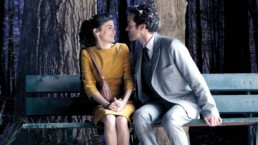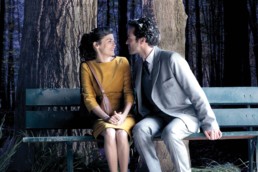Review: ‘Mood Indigo’
A mixture of homemade special effects and stop motion, creativity is something Gondry excels in once again.
As Eternal Sunshine of the Spotless Mind is one of my favorite films of recent years, I was looking forward to director Michel Gondry’s latest surrealist project. I even found myself squirming with anticipation in the viewing room and audibly giggling before the screening began. But upon finishing Mood Indigo, I had mixed feelings about this French visionary’s most recent work.
Gondry’s latest surrealist affair is an adaptation of the previously regarded “unfilmable” novel, Froth on a Daydream, which is written by French polymath Boris Vian. Mood Indigo focuses on Colin (Romain Duris), a happy-go-lucky and rather proper man who resides in a lively little apartment with his chef and lawyer, Nicolas (Omar Sy). Soon enough, Colin meets Chloe (Audrey Tautou) and falls in love almost immediately, as most fictional characters do. The two then partake in lovey dovey adventures throughout Paris, and what follows is an immensely imaginative and quite colorful experience, including a scene where Chloe and Colin ride through the sky on a cloud. But unfortunately, Mood Indigo quickly begins to focus too much on spectacle rather than emotion, tone, and compelling romance.
Mood Indigo quickly begins to focus too much on spectacle rather than emotion, tone, and compelling romance.
For instance, our two leading protagonists seem to jump onto the altar together before one can even begin to become emotionally invested in either character. The wedding scene is rather entertaining and memorable, luckily, with a split screen showcasing rain on one side and radiant sunshine on the other. But their honeymoon comes to an end when a doctor (played by Gondry himself) tells Chloe that she has a flower growing in her lungs and she will die unless she is kept close to fresh flowers.
Interestingly, as Chloe’s condition begins to worsen, the apartment itself changes as well. Colin’s apartment serves as a living, breathing organism in the film, and things such as color and size, and even small details often reflect Chloe’s personal state of health.
Mood Indigo’s visuals are quite the wondrous feat. A mixture of homemade special effects and stop motion, creativity is something Gondry excels in once again. But even so, the surrealism starts to become exhausting and even distracting mid-film. I found that I was completely detached from the characters and that I was simply watching wacky surrealist interactions occur on all corners of the screen at all times.
Whether or not the source material is to blame here is questionable, suffice it to say that I sure do miss a writer like Kaufman collaborating with Gondry, because Mood Indigo is like a never ending set of cute stunts, which feel more like a series of music videos than a narrative film. Even with the American cut, which is down to 90 minutes, the film seemed too long.
While certain images and set pieces from the film have definitely become unstuck in my mind, for instance a piano that makes cocktails or the room full of typists who are writing out Colin’s life on endless typewriters, the story is too emotionless and full of sensory overload for anyone to care too much about this Gondry flick, which is truly tragic.


